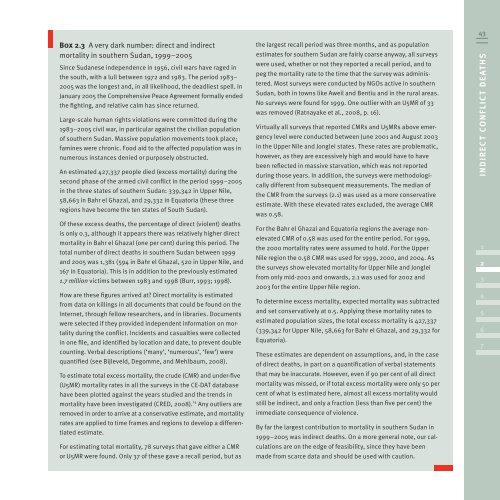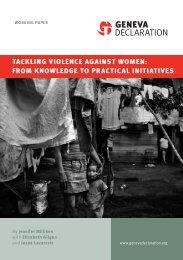Global Burden of Armed Violence - The Geneva Declaration on ...
Global Burden of Armed Violence - The Geneva Declaration on ...
Global Burden of Armed Violence - The Geneva Declaration on ...
You also want an ePaper? Increase the reach of your titles
YUMPU automatically turns print PDFs into web optimized ePapers that Google loves.
Box 2.3 A very dark number: direct and indirect<br />
mortality in southern Sudan, 1999–2005<br />
Since Sudanese independence in 1956, civil wars have raged in<br />
the south, with a lull between 1972 and 1983. <str<strong>on</strong>g>The</str<strong>on</strong>g> period 1983–<br />
2005 was the l<strong>on</strong>gest and, in all likelihood, the deadliest spell. In<br />
January 2005 the Comprehensive Peace Agreement formally ended<br />
the fighting, and relative calm has since returned.<br />
Large-scale human rights violati<strong>on</strong>s were committed during the<br />
1983–2005 civil war, in particular against the civilian populati<strong>on</strong><br />
<str<strong>on</strong>g>of</str<strong>on</strong>g> southern Sudan. Massive populati<strong>on</strong> movements took place;<br />
famines were chr<strong>on</strong>ic. Food aid to the affected populati<strong>on</strong> was in<br />
numerous instances denied or purposely obstructed.<br />
An estimated 427,337 people died (excess mortality) during the<br />
sec<strong>on</strong>d phase <str<strong>on</strong>g>of</str<strong>on</strong>g> the armed civil c<strong>on</strong>flict in the period 1999–2005<br />
in the three states <str<strong>on</strong>g>of</str<strong>on</strong>g> southern Sudan: 339,342 in Upper Nile,<br />
58,663 in Bahr el Ghazal, and 29,332 in Equatoria (these three<br />
regi<strong>on</strong>s have become the ten states <str<strong>on</strong>g>of</str<strong>on</strong>g> South Sudan).<br />
Of these excess deaths, the percentage <str<strong>on</strong>g>of</str<strong>on</strong>g> direct (violent) deaths<br />
is <strong>on</strong>ly 0.3, although it appears there was relatively higher direct<br />
mortality in Bahr el Ghazal (<strong>on</strong>e per cent) during this period. <str<strong>on</strong>g>The</str<strong>on</strong>g><br />
total number <str<strong>on</strong>g>of</str<strong>on</strong>g> direct deaths in southern Sudan between 1999<br />
and 2005 was 1,381 (594 in Bahr el Ghazal, 520 in Upper Nile, and<br />
167 in Equatoria). This is in additi<strong>on</strong> to the previously estimated<br />
1.7 milli<strong>on</strong> victims between 1983 and 1998 (Burr, 1993; 1998).<br />
How are these figures arrived at? Direct mortality is estimated<br />
from data <strong>on</strong> killings in all documents that could be found <strong>on</strong> the<br />
Internet, through fellow researchers, and in libraries. Documents<br />
were selected if they provided independent informati<strong>on</strong> <strong>on</strong> mortality<br />
during the c<strong>on</strong>flict. Incidents and casualties were collected<br />
in <strong>on</strong>e file, and identified by locati<strong>on</strong> and date, to prevent double<br />
counting. Verbal descripti<strong>on</strong>s (‘many’, ‘numerous’, ‘few’) were<br />
quantified (see Bijleveld, Degomme, and Mehlbaum, 2008).<br />
To estimate total excess mortality, the crude (CMR) and under-five<br />
(U5MR) mortality rates in all the surveys in the CE-DAT database<br />
have been plotted against the years studied and the trends in<br />
mortality have been investigated (CRED, 2008). 14 Any outliers are<br />
removed in order to arrive at a c<strong>on</strong>servative estimate, and mortality<br />
rates are applied to time frames and regi<strong>on</strong>s to develop a differen-<br />
tiated estimate.<br />
For estimating total mortality, 78 surveys that gave either a CMR<br />
or U5MR were found. Only 37 <str<strong>on</strong>g>of</str<strong>on</strong>g> these gave a recall period, but as<br />
the largest recall period was three m<strong>on</strong>ths, and as populati<strong>on</strong><br />
estimates for southern Sudan are fairly coarse anyway, all surveys<br />
were used, whether or not they reported a recall period, and to<br />
peg the mortality rate to the time that the survey was adminis-<br />
tered. Most surveys were c<strong>on</strong>ducted by NGOs active in southern<br />
Sudan, both in towns like Aweil and Bentiu and in the rural areas.<br />
No surveys were found for 1999. One outlier with an U5MR <str<strong>on</strong>g>of</str<strong>on</strong>g> 33<br />
was removed (Ratnayake et al., 2008, p. 16).<br />
Virtually all surveys that reported CMRs and U5MRs above emer-<br />
gency level were c<strong>on</strong>ducted between June 2001 and August 2003<br />
in the Upper Nile and J<strong>on</strong>glei states. <str<strong>on</strong>g>The</str<strong>on</strong>g>se rates are problematic,<br />
however, as they are excessively high and would have to have<br />
been reflected in massive starvati<strong>on</strong>, which was not reported<br />
during those years. In additi<strong>on</strong>, the surveys were methodologi-<br />
cally different from subsequent measurements. <str<strong>on</strong>g>The</str<strong>on</strong>g> median <str<strong>on</strong>g>of</str<strong>on</strong>g><br />
the CMR from the surveys (2.1) was used as a more c<strong>on</strong>servative<br />
estimate. With these elevated rates excluded, the average CMR<br />
was 0.58.<br />
For the Bahr el Ghazal and Equatoria regi<strong>on</strong>s the average n<strong>on</strong>-<br />
elevated CMR <str<strong>on</strong>g>of</str<strong>on</strong>g> 0.58 was used for the entire period. For 1999,<br />
the 2000 mortality rates were assumed to hold. For the Upper<br />
Nile regi<strong>on</strong> the 0.58 CMR was used for 1999, 2000, and 2004. As<br />
the surveys show elevated mortality for Upper Nile and J<strong>on</strong>glei<br />
from <strong>on</strong>ly mid-2001 and <strong>on</strong>wards, 2.1 was used for 2002 and<br />
2003 for the entire Upper Nile regi<strong>on</strong>.<br />
To determine excess mortality, expected mortality was subtracted<br />
and set c<strong>on</strong>servatively at 0.5. Applying these mortality rates to<br />
estimated populati<strong>on</strong> sizes, the total excess mortality is 427,337<br />
(339,342 for Upper Nile, 58,663 for Bahr el Ghazal, and 29,332 for<br />
Equatoria).<br />
<str<strong>on</strong>g>The</str<strong>on</strong>g>se estimates are dependent <strong>on</strong> assumpti<strong>on</strong>s, and, in the case<br />
<str<strong>on</strong>g>of</str<strong>on</strong>g> direct deaths, in part <strong>on</strong> a quantificati<strong>on</strong> <str<strong>on</strong>g>of</str<strong>on</strong>g> verbal statements<br />
that may be inaccurate. However, even if 90 per cent <str<strong>on</strong>g>of</str<strong>on</strong>g> all direct<br />
mortality was missed, or if total excess mortality were <strong>on</strong>ly 50 per<br />
cent <str<strong>on</strong>g>of</str<strong>on</strong>g> what is estimated here, almost all excess mortality would<br />
still be indirect, and <strong>on</strong>ly a fracti<strong>on</strong> (less than five per cent) the<br />
immediate c<strong>on</strong>sequence <str<strong>on</strong>g>of</str<strong>on</strong>g> violence.<br />
By far the largest c<strong>on</strong>tributi<strong>on</strong> to mortality in southern Sudan in<br />
1999–2005 was indirect deaths. On a more general note, our cal-<br />
culati<strong>on</strong>s are <strong>on</strong> the edge <str<strong>on</strong>g>of</str<strong>on</strong>g> feasibility, since they have been<br />
made from scarce data and should be used with cauti<strong>on</strong>.<br />
43<br />
I N D I R EC T CO N F L I C T DE AT H S<br />
1<br />
2<br />
3<br />
4<br />
5<br />
6<br />
7









